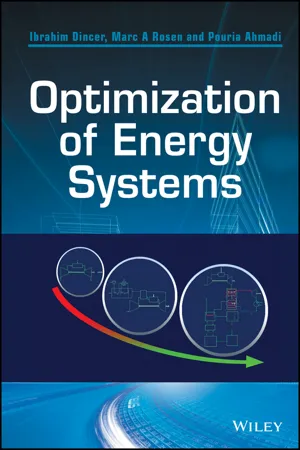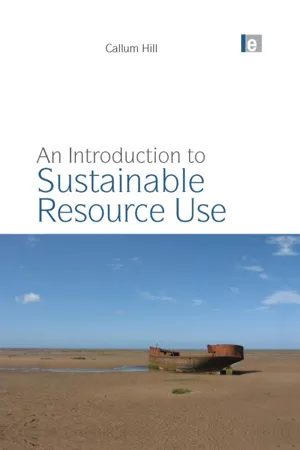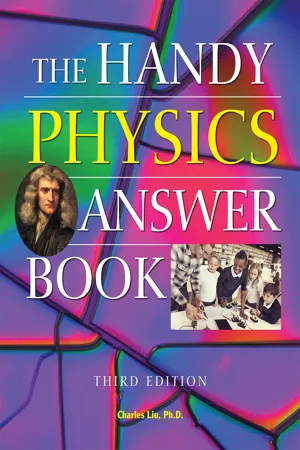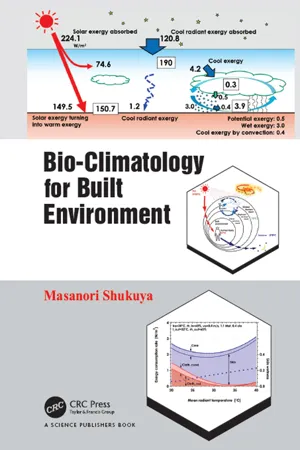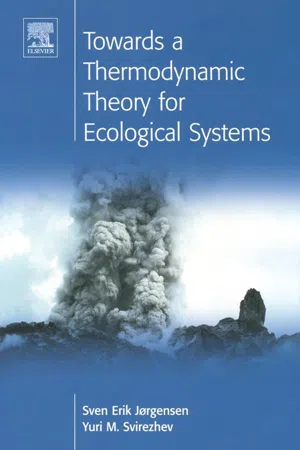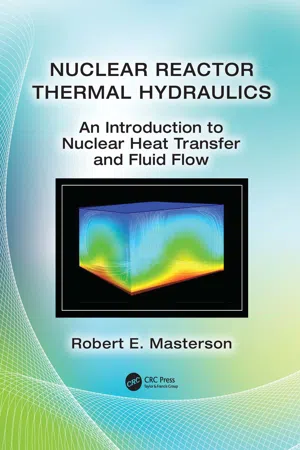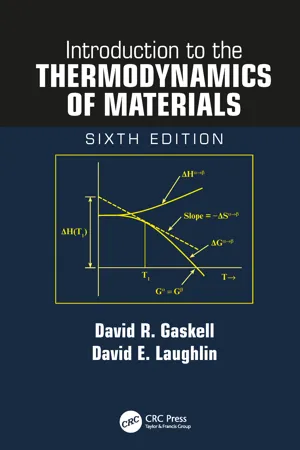Physics
Thermodynamics
Thermodynamics is the branch of physics that deals with the relationships between heat, work, and energy. It encompasses the study of how energy is transferred as heat and work, and how these processes affect the properties of matter. Thermodynamics also includes the laws governing these energy transformations, such as the first and second laws of thermodynamics.
Written by Perlego with AI-assistance
Related key terms
Related key terms
1 of 4
Related key terms
1 of 3
12 Key excerpts on "Thermodynamics"
- eBook - ePub
- Tangellapalli Srinivas, N. Shankar Ganesh, R. Shankar(Authors)
- 2019(Publication Date)
- Apple Academic Press(Publisher)
CHAPTER 3 BASIC Thermodynamics ABSTRACTThe study and evaluation of any thermal system need basic Thermodynamics principles. They provide the primary and essential steps of system planning, namely, thermodynamic modeling, simulation, analysis and optimization. The mass balance, energy balance, and exergy balance follow the laws of Thermodynamics. The properties of working fluid such as pressure, temperature, volume, entropy, internal energy, enthalpy, exergy, etc. can be developed from the thermodynamic relations. The discussed contents in this chapter are concepts, laws of Thermodynamics, thermodynamic processes, and fundamental relations.3.1 INTRODUCTIONThermodynamics is a branch of science that focuses on heat, work, its conversion, and evaluation. It plays a great role in the thermal system development. The main functions of Thermodynamics in engineering are all managerial functions such as planning, coordination, etc. Surrounding us, the nature has tremendous amount of energy. The energy always tries to convert one form to another form. Thermodynamics deals about these energy interactions in a systematic way with reference to certain rules called thermodynamic laws. Sadi Carnot developed many theories in Thermodynamics and he is called the father of Thermodynamics. Thermodynamics deals with energy, entropy, exergy, and equilibrium. Thermo-economics deals with economics in addition to these four “e”s. All the Thermodynamics laws, namely, zero, first, second, and third are designed based on logics and without mathematical proof.In engineering, the solutions can be categorized into two groups: one is rating (finding the capacity) and the second is sizing. The quantification of energy interactions and capacity finding are the part of rating of an engineering system. Finding the dimensions of a system through a system of methodology is called sizing or design. Thermodynamics deals only with the rating and it can support the sizing which is the limitation of Thermodynamics. But the data or information required to do the size can be obtained through the thermodynamic evaluation. The use of Thermodynamics is vast and used in many applications such as aerodynamics, automobile engineering, power plants, refrigeration and air conditioning, cogeneration, steam engines, internal combustion engines, steam and gas turbines, fuel cells, thermo-electric and thermo-ionic generators, chemical reactions, phase equilibrium, etc. Thermodynamics is similar to the engineering mechanics which is the main origin of engineering design subjects. Similar to engineering mechanics, Thermodynamics is the mother of thermal engineering subjects. In the engineering mechanics, force balance and moment equations solve the structure under the equilibrium condition. In Thermodynamics, the mass balance and energy balance solves the performance of thermal system. - eBook - ePub
- Ibrahim Dinçer, Marc A. Rosen, Pouria Ahmadi(Authors)
- 2017(Publication Date)
- Wiley(Publisher)
This chapter provides such a review, and is intended to give novice and practicing energy systems engineers a strong understanding of fundamentals, including physical phenomena, basic laws and principles, and governing relations, as well as a solid grounding in practical aspects. This introductory chapter covers relevant fundamentals involved in the optimization of energy systems. We begin the chapter with a summary of fundamental definitions and physical quantities, with their units, dimensions, and interrelations. We then consider introductory aspects of Thermodynamics, with a particular focus on energy, exergy, and heat transfer.1.2 Thermodynamics
Energy is needed for almost every activity. In simple terms, energy is usually thought of as the ability to carry out useful tasks like producing work and heating. Energy is contained in the fuel we use, the food we eat, and the places we live. Energy enables such outcomes as transportation, fresh water, and thermal comfort in buildings.Energy use has drawbacks too. It can be dangerous if not used cautiously and often leads to pollution and environmental damage.Energy can be converted from one form to another, but cannot be created or destroyed. Work and heat are two categories of energy in transit. Thermodynamics plays a key role in the analysis of processes, systems, and devices in which energy transfers and transformations occur. The implications of Thermodynamics are far reaching and applications span the range of human enterprise. Nature allows the conversion of work completely into heat, but not the reverse. Additionally, converting heat into work requires a device, which is often complex (e.g., an engine).Although energy can be transformed into different forms, the principle of conservation of energy states that the total energy of a system can only change if energy is transferred into or out of the system. This implies that it is impossible to create or destroy energy. The total energy of a system can this be calculated by adding all forms of energy in the system. Examples of energy transfer and transformation include generating or making use of electric energy, performing chemical reactions and lifting an object. Lifting against gravity performs work on the object and stores gravitational potential energy; if the object falls, gravity does work on the object, which transforms its potential energy into kinetic energy associated with its speed. - eBook - ePub
- Majid Ghassemi, Azadeh Shahidian(Authors)
- 2017(Publication Date)
- Academic Press(Publisher)
Chapter 2Thermodynamics
Abstract
Thermodynamics generally starts with several basic concepts and leads to different Thermodynamics laws. A thermodynamic system is a quantity of matter, which is defined by its boundary. In this chapter after short review of thermodynamic laws, nanothermodynamic and thermodynamic properties of nanosized systems are presented. They are essential topics in nanosize engineering examples. Since it is necessary to know the energy transductions that occur between living organisms and cells, the biological Thermodynamics is considered. At the end of this chapter the energy and exergy of the human body as an open thermodynamic system is analyzed and obtained results are discussed.Keywords
Energy analysis; Exergy analysis; Human body; Nanothermodynamic; Thermodynamics laws; Thermodynamics of biosystems2.1. Fundamental
Thermodynamics consists of two words: thermo (heat) and dynamics (power). It is a branch of science that deals with conversion of heat to work. It was established in the 19th century [1] . Historically, it dealt only with work generated by a hot body (heat engine) and efforts to make it a more efficient heat engine. Today, Thermodynamics deals mostly with energy and its relationship between properties of substances.Thermodynamics generally starts with several basic concepts and leads to different Thermodynamics laws. A thermodynamic system is a quantity of matter, which is defined by its boundary. Everything outside the boundary is called the surroundings or environment. The environment often contains one or more idealized heat reservoirs—heat sources with infinite heat capacity enabling them to give up or absorb heat without changing their temperature. The boundary can be real or imaginary, fixed or movable. There are two types of systems: closed and open. A closed system (control mass) is a system with fixed quantity of matter. Thus, no mass crosses the boundary of the system. In an open system (control volume) the quantity of mass is not constant and mass can cross the boundary. An open system exchanges both matter and energy with its surroundings, whereas a closed system exchanges only energy with its surroundings. The isolated system exchanges neither energy nor matter with its surroundings. An example of a true isolated system is the universe with energy stored in it. - eBook - ePub
The Language of Modern Physics
An Introduction to the Philosophy of Science
- Ernest H. Hutten(Author)
- 2022(Publication Date)
- Routledge(Publisher)
But Thermodynamics is more general in scope; it uses the wider concept of energy to describe the behaviour of all sorts of systems. Heat phenomena are not of the same kind as mechanical or electric phenomena—they deal with systems rather than with individual masses or charges. It is a strange idea indeed that heat is regarded as being a separate phenomenon: as if only special systems exhibited the property of temperature. But the state of all systems must be described, among other variables, by the variable referring to temperature; not only mechanical, but electric, magnetic, and even quantum-mechanical systems possess this property, while ‘mass’, ‘charge’, and so on, are terms applicable only to certain systems. However, when we do an experiment at a moderate temperature, the thermal effect on any system is negligible; mainly for very low or very high temperatures do we find, experimentally, that temperature plays a decisive rôle in the physical process. Such extremes of temperature are practically difficult to produce so that we tend to forget them.Thermodynamics describes the general behaviour of systems, and it applies both to microscopic and macroscopic phenomena, to field physics as well as to quantum physics. The concept of system is applicable everywhere, and it suggests immediately large-scale phenomena and the statistical distribution of events. It is of course the concept of probability, and the statistical interpretation, that ultimately reveal the peculiar character of Thermodynamics.2. The conservation of energy
Poincaré once remarked that the scientist who first introduced the noun ‘heat’ to describe temperature phenomena has done a great disservice to science. For it suggests that heat is a substance, so that the ‘flow of heat’ is a phrase referring to a process similar to that of the flow of water. The caloric theory of heat was the outcome of this interpretation; unfortunately, we have retained some of the principal terms of the theory up to the present day, and this does not help in making clearer our ideas about heat. But, in some sense, this view is inevitable; it is in accord with the common sense interpretation underlying the thing-language of daily life. It suggests the simplest kind of semantic system, or model, and so provides implicitly some rules for the use of certain terms within a limited context. The concepts of specific heat or latent heat, etc., belong to this interpretation, and they have been used with great success. This ‘fluid’ model must be recognised as a tacit assumption for some statements of Thermodynamics.The next step in the development, say Rumford’s experiments, show that heat may be interpreted as a motion of the particles which make up a body. This molecular conception of heat as a kind of motion is said to go back to the ancients; it relates heat to the particle model of mechanics. Again, it was perhaps unfortunate that temperature phenomena were described, mainly, in terms of mechanics so that, even to-day, we find it difficult to interpret Thermodynamics except in these terms; but temperature is a universal characteristic and it applies to every kind of physical process. - eBook - ePub
- Callum Hill(Author)
- 2012(Publication Date)
- Routledge(Publisher)
2
Thermodynamics
(the science of energy and change)
Introduction
Thermodynamics is one of the most powerful tools at our disposal for the study of the sustainability of processes. Although a development that was associated with the invention of the steam engine, it has proved to be of much wider application in the fields of chemistry, ecology, biochemistry, cosmology and information theory. If we wish to understand anything about the sustainability of a process, it is clearly important to know about energy use, recycling and other facets concerned with the management or utilization of resources and it is Thermodynamics that provides the basis for the answers to many of the questions. Although this book concerns physical resources and their exploitation, it is necessary to use energy in the processing of these materials and so it follows that we have to understand the properties of energy and how it interacts with matter.What is energy?
Energy is used to move things, to drive machinery, to provide heat and electricity, and to stay alive. Without energy there would be no change and time would not exist. But what exactly is it? For many years energy was seen as a mysterious force that acted upon matter and somehow gave it ‘life’ and it was given a name that reflected this idea, ‘vis viva’. Even now, much misunderstanding exists; it is common to see the words ‘energy’ and ‘power’ used interchangeably although they mean different things, or references to energy ‘consumption’, whereas energy is always conserved. There is no doubt that something is being consumed when we use energy and we shall examine later in this chapter what this something is. - eBook - ePub
- Charles Liu(Author)
- 2020(Publication Date)
- Visible Ink Press(Publisher)
Thermodynamics
What is Thermodynamics?
Thermodynamics is the study of the change of thermal energy in objects and materials that makes them warm and cold, how they interact with each other, and the relationship between energy, heat, and work. It can be a challenging area of physics, in part because most of the vocabulary dates from the time before scientists understood what makes an object hot. Terms like “heat,” “heat capacity,” and “latent heat” suggest that warm objects contain some material that reacts to temperature. It wasn’t until the early 1800s that our present understanding started to develop. Some 200 years later, our common usage of these terms is still based on earlier ideas.What is thermal energy?
Thermal energy is the random kinetic energy of the moving particles—such as atoms and molecules—that make up matter. Objects expand when heated, so the bonds holding the particles together stretch. That means they have more elastic energy. So, thermal energy is the sum of the kinetic and elastic energy of the atoms and molecules and the bonds that hold them together. It is energy that is inside the object, so it is called a form of internal energy.THERMAL PHYSICS
Who discovered what makes an object hot?
Benjamin Thompson, Count Rumford (1753–1814), who was born in the Massachusetts Bay Colony but did most of his scientific work in the Kingdom of Bavaria (which is now part of Germany), deserves a great deal of credit in discovering what makes things hot. Before his experiments, most scientists thought that hot objects contained an invisible fluid called caloric. Experiments done before Rumford showed that when you heated an object it didn’t gain weight, so caloric must be weightless as well as invisible. This result made many scientists suspicious of the caloric explanation.In 1789 Rumford drilled holes in bronze cannons through which a cannonball would be shot. He found that both the cannon and the metal chips that resulted from the drilling became hot. He determined the amount of water that could be raised to the boiling point by both the cannon bodies and the chips and showed that the caloric theory did not agree with his results. He finally concluded that in hot objects, the particles that made up the material moved faster than they moved in cold objects. Using our present terminology, they had more kinetic energy. In their motion they vibrate back and forth; they do not move together from one place to another like a thrown ball. - eBook - ePub
- Masanori Shukuya(Author)
- 2019(Publication Date)
- CRC Press(Publisher)
Chapter 7 Thermodynamics 7.1 Work, heat and energyA variety of artificial systems driving our societies at large including contemporary buildings and cities are realised by the development of physical science and its engineering applications. The physical science taught in modern academia has been usually considered to consist of the following three branches: mechanics, electromagnetics and Thermodynamics; we can say so looking at the curricula arranged for science and engineering education in universities.Thermodynamics stands unique compared to mechanics and electromagnetics since it focuses directly on “dispersion” that necessarily takes place in actual macroscopic phenomena. In other words, as far as the mechanics and electromagnetics confine their focus on the behaviour of celestial bodies or charged particles, they may look having nothing to do with Thermodynamics.Nonetheless, all of the mechanical and electromagnetic phenomena that we experience in everyday life can never escape from thermodynamic phenomena, that is, the dispersion of heat and matter involved. The branches of mechanical and electrodynamic sciences, having been taught as major courses, tend to ignore the consequence of dispersion and thereby seem to result in letting those students ignore the thermodynamic consequence of actual macroscopic phenomena; therefore, they should be further re-developed taking Thermodynamics into consideration so that one can develop his or her own holistic and connective ways of thinking in learning mechanics and electromagnetics. This is, I think, important in particular for the contemporary technology to advance further towards more environmentally-benign and better solutions.In Chapter 2 , subsection 2.5.2 , we already discussed how a heat engine can produce “work” by a series of thought experiment. We also already made clear what the “heat” and “temperature” are in Chapter 6 , section 6.2 - S.E. Jorgensen, Y.M. Svirezhev(Authors)
- 2004(Publication Date)
- Pergamon(Publisher)
When I had been a student, I have read with pleasure F. Wald’s small book under the title “The Queen of the World and her Shadow”. Energy and entropy were kept in mind. Now, when I understand these concepts deeper, I think that their positions should be interchanged. In the giant factory of natural processes the entropy law is a director who controls and manages all the business, while the energy conservation law is only an accountant who is keeping a balance between debit and credit.Robert Emden , 1938.2.1 Introduction
Following a classic biosphere and ecological tradition (Vernadsky, 1926 ; Lindeman, 1942 ), we can say that the structure, functioning and evolution of the biosphere, as a whole, and ecosystems in particular, are mainly determined by the flows of matter, heat and radiation. A physical study of their interaction is possible in the framework of Thermodynamics. The subject of classic Thermodynamics is the consideration of conformities in energy transformations when they are transferred between different physical bodies (which we shall call “systems”) in the form of heat and work. Thermodynamics methods are applicable to so-called macroscopic systems consisting of a great number of particles. In physics, the particles are molecules.Thermodynamics is now one of the most complete and elegant chapters of theoretical physics. However, the domain of the applications of its general concept and methods is much larger than purely physical and chemical systems. Generally speaking, a Thermodynamics approach allows us to describe general (macroscopic, systemic ) properties of the systems consisting of the large number of interacting elementary (microscopic ) objects (particles ). Therefore, when we talk about a thermodynamic approach in such a semi-empirical and phenomenological natural science as ecology, we hope implicitly that these methods help us to overcome an ecological “perdition of dimension”. In other words, we could reduce a huge number of the individual descriptions of specimens, populations, their interactions, concentrations of different chemical substances, etc. to a few macroscopic- eBook - ePub
- Vinay Ambegaokar(Author)
- 2017(Publication Date)
- Dover Publications(Publisher)
9 Heat, work, and putting heat to work A man hath sapiences thre Memorie, engin and intellect also Chaucer Engines are, etymologically and in fact, ingenious things. By the end of this chapter we shall understand heat-engines, which are devices that convert ‘heat’ – an intuitive idea to be made precise here – into pushes or pulls or turns. First, however, we need to systematize some of the things we have already learnt about energy and entropy, and thereby extract the science of Thermodynamics from the statistical viewpoint of the last chapter. Thermodynamics is a theory based on two ‘Laws,’ which are not basic laws of nature in the sense mentioned in Chapter 1, but commonsense rules concerning the flow of energy between macroscopic systems. From the point of view we are taking here, these axioms follow from an understanding of the random motion of the microscopic constituents of matter. It is a tribute to the genius of the scientists – particularly Carnot, Clausius, and Kelvin – who formulated Thermodynamics as a macroscopic science, that their scheme is in no way undermined by the microscopic view, which does, however, offer a broader perspective and open up avenues for more detailed calculations. (For example, effusion – discussed at the end of the last chapter – lies beyond the scope of Thermodynamics.) Work, heat, and the First Law of Thermodynamics The First Law of Thermodynamics is about the conservation of energy. The concept is the one we encountered in Chapter 6 where, you will recall, we found that a falling body could be thought of as converting potential energy into kinetic energy – the sum of the two remaining constant. The important distinction for Thermodynamics is somewhat different - eBook - ePub
- Roger Tim Haug(Author)
- 2019(Publication Date)
- CRC Press(Publisher)
4Life and Energy: The Principles of Chemical and Photo ThermodynamicsThe proper study of biology should start from thermodynamic principles. In fact, energy and its transformations may be viewed as the central theme which can best systematize biological facts and theory.Albert Lehninger (1965)Thermodynamics is one of those words best avoided in a book with any pretence to be popular. Nick Lane (2009)What Is Thermodynamics?
Thermodynamics is the branch of science that deals with energy, its transformations, and the energy changes that accompany physical, chemical, and biological processes. Thermodynamics is a basic unifying concept of all science, including physics, chemistry, and biology. For most organisms, life is a near constant struggle or search for energy supplies needed to power the cellular machinery. This is certainly true of the microbes. With the development of agriculture, man was able to free himself from the constant search for food energy. Nevertheless, the human body is constantly “burning” various stored substances for energy. If these stored reserves are not replaced at periodic intervals, death is inevitable. Microbes spend nearly their entire life cycle in the search for energy. If times are lean, some microbes can go into a dormant state and reemerge when conditions improve. Even these must eventually find an energy source, or death is certain.Although the need for an energy supply is common to all life forms, the actual sources can be markedly different. The study of different energy sources available to microbes is probably the best approach to understanding the differences between life forms. These energy sources include organic “foods,” inorganic “foods,” and the energy of light. Understanding these sources of energy will also lead to a better understanding of reactions that microbes mediate and the useful tasks to which they can be directed in properly engineered systems. - eBook - ePub
Nuclear Reactor Thermal Hydraulics
An Introduction to Nuclear Heat Transfer and Fluid Flow
- Robert E. Masterson(Author)
- 2019(Publication Date)
- CRC Press(Publisher)
Thermodynamics can be used to determine the quantity of work to be performed, and it can be used to describe how much heat is to be exchanged during this process. However, it does not indicate the specific mechanism or mechanisms by which this can be achievedHeat transfer describes a specific form of energy transfer that requires the existence of a temperature gradient. The specific method of energy transfer is based on the existence of this temperature gradient, and no thermal energy can be transferred without it6.15 Other Comparisons between Thermodynamics and Heat Transfer
. Another way to understand this difference is to consider the cooling of a hot steel bar in a tub of cold water. Thermodynamics can be used to predict the final equilibrium temperature T∞ of the water–bar combination, but it CANNOT be used to find how long it will take to reach this temperature. Thermodynamics can also not be used to find the temperature of the steel bar a certain amount of time before an equilibrium condition has been reached. However, the equations of heat transfer can be used to predict the temperatures of both the bar and the water as a function of time. In other words, the science of heat transfer combines the principles of Thermodynamics with a rate equation to allow us to predict the rate of heat transfer as we depart from an equilibrium condition :The other fundamental difference between Thermodynamics and heat transfer is that the former involves finding the thermodynamic state of a material, whereas the latter involves using this state to calculate the rate at which energy is exchanged- Heat transfer = Thermodynamics + Rate equations(s)
6.16 Thermodynamic Properties, Systems, and States
Now that we have gotten some of the preliminaries out of the way, we would like to say a few words about a number of thermodynamic concepts that we will be using in this book. We will start with some obvious concepts, and we will then progress to some of the less obvious ones. In any event, the quantities that we will discuss are very important for a number of reasons, and so we would like to formally define them for you now. - eBook - ePub
- David R. Gaskell, David E. Laughlin(Authors)
- 2017(Publication Date)
- CRC Press(Publisher)
2 The First Law of Thermodynamics 2.1INTRODUCTIONThe First Law of Thermodynamics is sometimes thought to be merely an extension to the Law of Conservation of Energy, which was discovered in the late seventeenth century for mechanical systems. It is, however, much more! The First Law introduces the important thermodynamic state variable internal energy , U (also called a thermodynamic potential ), and the law posits that energy may be converted from one of its forms to another form. Furthermore, the law introduces the important concept that the transfer of thermal energy (heat) is a different kind of energy than that which is done during a process of work . First, we start with a review of basic mechanics.Kinetic energy is conserved in a frictionless system of interacting rigid elastic bodies. A collision between two of these bodies results in a transfer of kinetic energy from one to the other; the work done by the one equals the work done on the other. The total kinetic energy of the system is unchanged as a result of the collision. If the kinetic system is in the influence of a gravitational field, then the sum of the kinetic and potential energies of the bodies is constant. Changes of position of the bodies in the gravitational field, in addition to changes in the velocities of the bodies, do not alter the total dynamic energy of the system. As the result of possible interactions, kinetic energy may be converted to potential energy and vice versa, but the sum of the two remains constant. If, however, friction occurs in the system, then with continuing collision and interaction among the bodies, the total dynamic energy of the system decreases and thermal energy is produced. It is thus reasonable to expect that a relationship exists between the dynamic energy dissipated and the thermal energy produced as a result of the effects of friction.The establishment of such a relationship laid the foundations for the development of the thermodynamic method. As a subject, this has now gone far beyond simple considerations of the interchange of energy from one form to another—for example, from dynamic energy to thermal energy. The development of Thermodynamics from its early beginnings to its present state was achieved as the result of the invention of convenient thermodynamic functions of state . In this chapter, the first two of these thermodynamic functions—the internal energy , U , and the enthalpy , H
Index pages curate the most relevant extracts from our library of academic textbooks. They’ve been created using an in-house natural language model (NLM), each adding context and meaning to key research topics.
Explore more topic indexes
Explore more topic indexes
1 of 6
Explore more topic indexes
1 of 4

